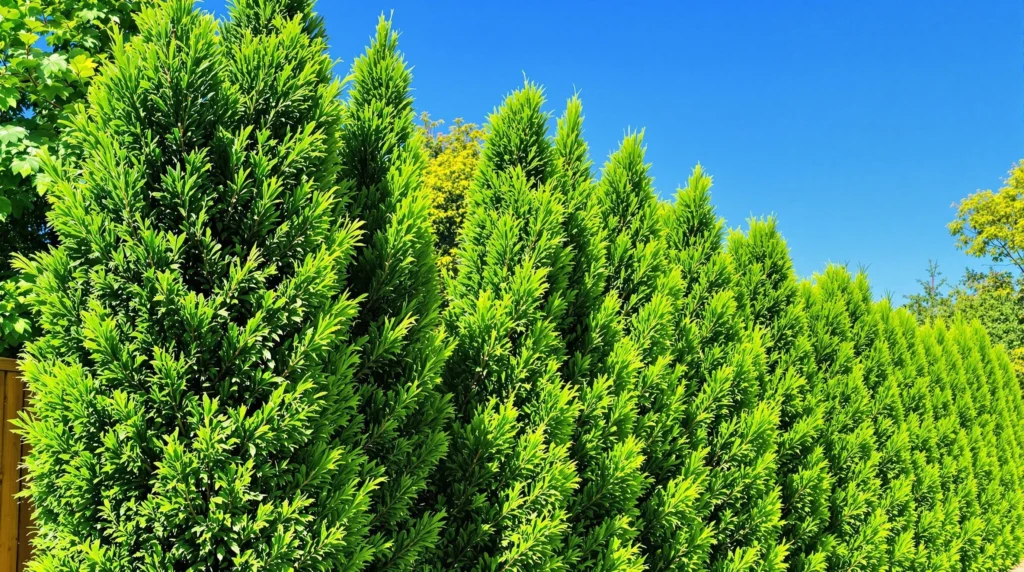10 Fast-Growing Privacy Trees to Plant Along Your Fence Line
- Leyland Cypress – This popular privacy tree grows up to 3-5 feet per year, reaching heights of 40-60 feet with a spread of 15-20 feet. Its dense, feathery foliage creates an excellent year-round screen and thrives in USDA zones 6-10. Leyland Cypress requires minimal maintenance but needs full to partial sun exposure.
- Thuja Green Giant – Growing 3-5 feet annually, Thuja Green Giant reaches 40-60 feet tall with a 12-20 foot spread. This arborvitae variety maintains its rich green color throughout winter and resists most pests and diseases. It’s adaptable to various soil types and performs well in zones 5-9.
- Italian Cypress – With its distinctive columnar shape, Italian Cypress grows 2-3 feet yearly to heights of 40-60 feet while staying narrow at just 4-6 feet wide. This drought-tolerant Mediterranean native thrives in zones 7-11 and requires minimal pruning to maintain its elegant silhouette.
- Nellie Stevens Holly – This broadleaf evergreen grows 2-3 feet per year, reaching 15-25 feet tall with a 10-15 foot spread. Its glossy, dark green leaves and bright red winter berries offer ornamental value alongside privacy. Nellie Stevens Holly performs best in zones 6-9 and tolerates partial shade.
- Emerald Green Arborvitae – Perfect for smaller spaces, this compact variety grows 1-2 feet annually to a mature height of 12-14 feet with a 3-4 foot width. Its bright green foliage remains vibrant year-round in zones 2-7, making it one of the most cold-hardy privacy options available.
- Eastern Red Cedar – This native conifer grows 1-2 feet per year, reaching 40-60 feet tall with a 10-20 foot spread. Its dense, aromatic foliage ranges from blue-green to bronze in winter. Eastern Red Cedar adapts to poor soils, drought conditions, and thrives in zones 2-9.
- Bamboo – For extremely rapid privacy, clumping bamboo varieties grow 3-5 feet annually, reaching 10-20 feet tall depending on the species. Unlike running bamboo, clumping varieties stay contained and create dense screens in zones 5-10. Plant in well-drained soil with consistent moisture.
- Wax Myrtle – This versatile evergreen grows 3-5 feet per year to heights of 10-15 feet with a similar spread. Its aromatic leaves repel insects naturally, and it thrives in wet conditions where other trees struggle. Wax Myrtle performs well in zones 7-11 and tolerates salt spray in coastal areas.
- Murray Cypress – Growing 3-4 feet annually, Murray Cypress reaches 30-40 feet tall with a 10-15 foot spread. This improved Leyland Cypress alternative offers better disease resistance and drought tolerance once established. It maintains dense foliage from ground to top in zones 6-10.
- Willow Hybrid – For the fastest possible privacy screen, Willow Hybrids grow an impressive 6-10 feet per year, reaching 35-45 feet tall with a 20-30 foot spread. These deciduous trees thrive near water sources in zones 4-9 but require regular pruning to control their vigorous growth habit.
Why Privacy Trees Are Essential for Boundary Fences
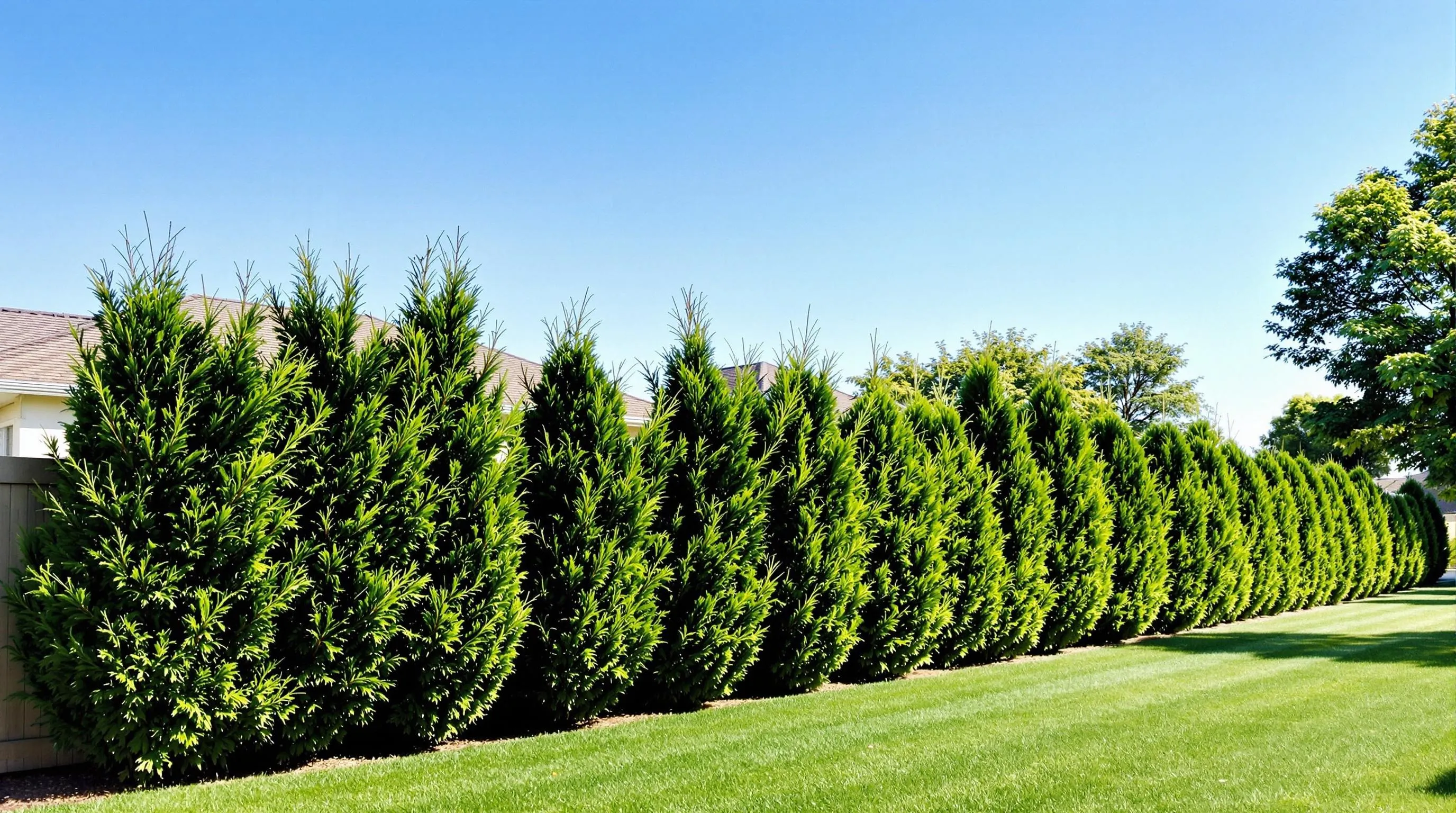
Privacy trees do more than just create a visual barrier along your fence line—they transform your outdoor space into a secluded retreat while solving multiple property challenges simultaneously. When strategically planted, these natural screens establish clear boundaries while improving your industry in ways that traditional fencing alone cannot achieve.
Security and Noise Reduction Benefits
Privacy trees significantly boost your property’s security by creating a natural barrier that discourages unwanted access. The dense foliage makes it difficult for potential intruders to see your property’s layout or valuable outdoor items. Many privacy trees like Thuja Green Giant and Nellie Stevens Holly feature thorny branches or dense growth patterns that act as physical deterrents. Beyond security, these trees excel at noise reduction, absorbing sound waves from busy streets or noisy neighbors. Research shows that a well-designed tree barrier can reduce ambient noise by 5-10 decibels—making your outdoor space noticeably quieter and more peaceful. For homes near highways or commercial areas, trees like Leyland Cypress and Eastern Red Cedar work as natural sound barriers, filtering out urban noise pollution while creating your own tranquil environment.
Property Value Enhancement
Strategically planted privacy trees can increase your property value by 5-20% according to real estate experts. Well-established trees are considered valuable industry assets that potential buyers willingly pay premium prices for. Privacy trees effectively extend your living space by creating functional outdoor rooms that feel like natural extensions of your home. Properties with mature, well-maintained tree screens typically sell faster and command higher prices than comparable properties without this landscaping feature. Beyond immediate financial benefits, privacy trees provide substantial energy savings by blocking winter winds and summer sun, potentially reducing heating and cooling costs by up to 25% annually. Trees like Italian Cypress and Murray Cypress offer this dual benefit of privacy and energy efficiency, making them particularly attractive to environmentally conscious homebuyers.
Leyland Cypress: The Rapid Shield Creator
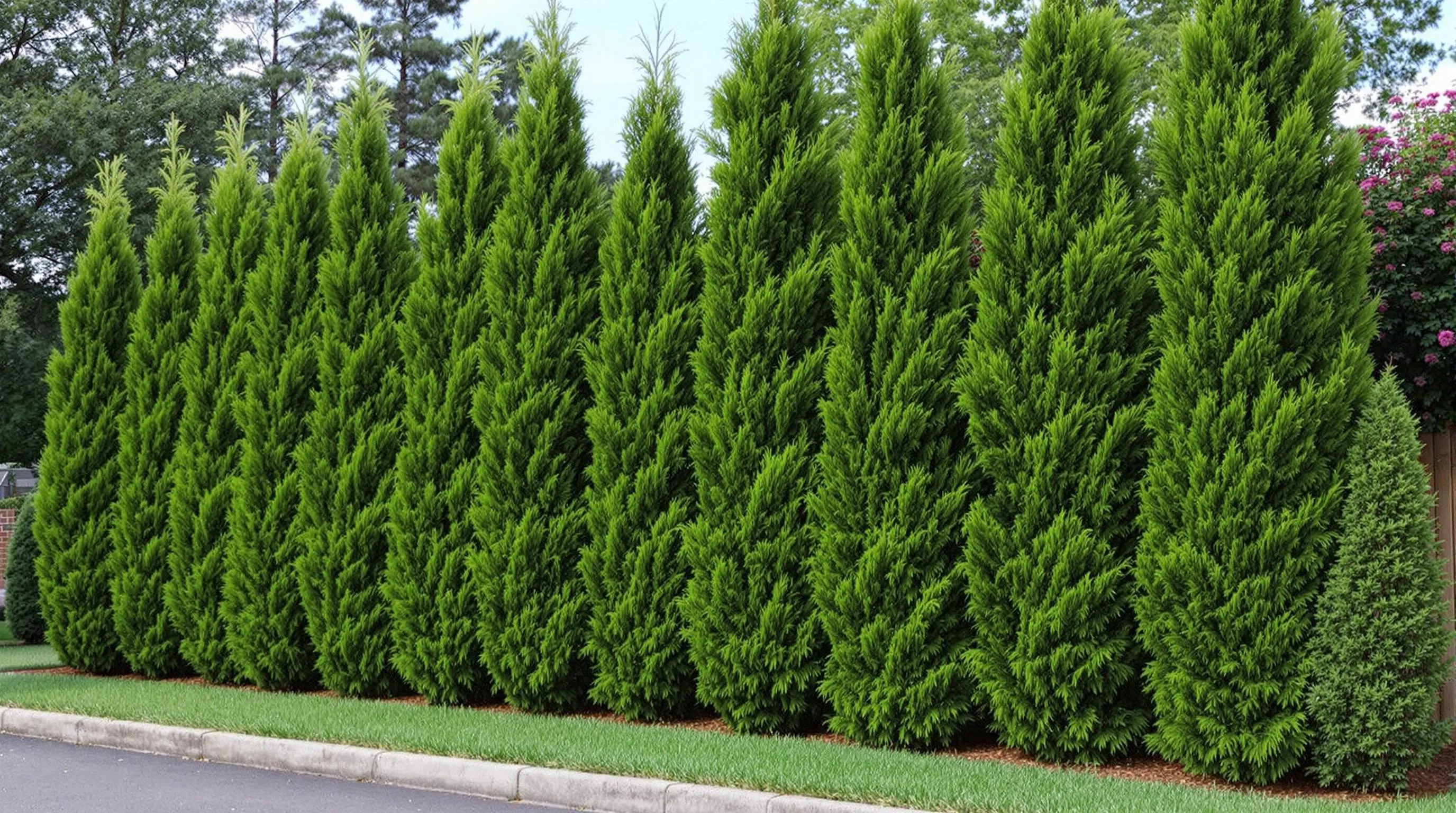
Leyland Cypress trees are the go-to solution for homeowners seeking quick privacy along fence lines. These evergreen powerhouses combine remarkable growth speed with dense foliage, creating a living wall that effectively blocks unwanted views and noise.
Growth Rate and Maximum Height
Leyland Cypress trees grow at an impressive rate of 3-5 feet per year during their early stages, making them one of the fastest-growing privacy options available. You’ll notice important height gains each season, with trees reaching 40-60 feet tall at maturity with a spread of 15-20 feet. Their columnar shape means they won’t take up excessive horizontal space, making them perfect for property boundaries. The dense, feathery foliage creates a solid visual barrier year-round, maintaining its blue-green color throughout all seasons without thinning during winter months.
Planting and Care Requirements
Planting Leyland Cypress trees requires minimal effort for maximum results. Space trees 6-10 feet apart for an optimal privacy screen, placing them at least 5 feet from fences or structures to accommodate root growth. These adaptable trees thrive in USDA hardiness zones 6-10 and prefer full sun to partial shade locations. While they tolerate various soil conditions, including clay and sandy soils, they perform best in well-draining soil with a neutral to slightly acidic pH. Water deeply twice weekly during the first growing season, then reduce to once weekly thereafter. Apply a balanced, slow-release fertilizer in early spring for optimal growth. Prune annually in late winter to early spring to maintain desired height and encourage dense growth. While generally resistant to pests, monitor for bagworms and canker disease, especially in humid conditions.
Thuja Green Giant: A Popular Privacy Solution
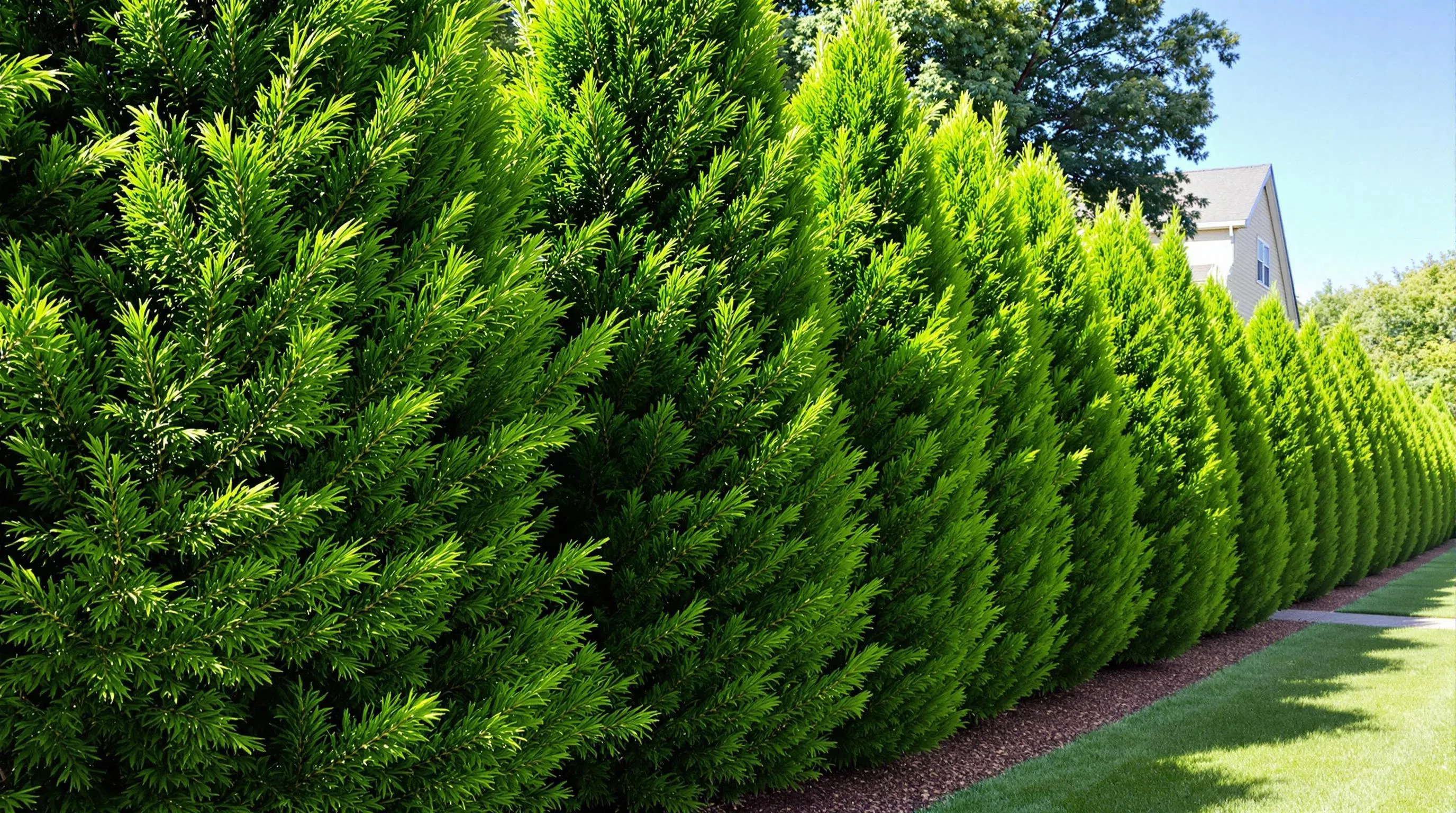
Thuja Green Giant has earned its reputation as one of America’s most sought-after privacy trees, growing an impressive 3-5 feet annually until reaching its mature height of 20-40 feet. This versatile evergreen maintains its rich green color year-round and creates a dense living wall that effectively blocks unwanted views while adding aesthetic value to your property. Its adaptability to various soil types and resistance to most pests make it an excellent choice for homeowners seeking quick privacy answers.
Space Requirements and Growth Patterns
When planting Thuja Green Giants along your fence line, proper spacing is crucial for optimal growth and effectiveness. Space these trees 5-8 feet apart for a solid privacy screen—closer spacing creates an immediate barrier, while wider spacing allows each tree to develop its full width. Thuja Green Giants develop a pyramidal to conical shape with a mature width of 12-20 feet, so consider this spread when planning your layout. They perform best in USDA hardiness zones 5-9 and prefer full to partial sun exposure (at least 4-6 hours daily). Their root systems are relatively non-invasive compared to other fast-growing trees, making them fence-friendly options that won’t damage nearby structures or hardscaping elements.
Maintenance Tips for Healthy Growth
Maintaining Thuja Green Giants requires minimal effort compared to other privacy options. Water deeply once or twice weekly during the first growing season to establish strong root systems, then reduce to supplemental watering during extended dry periods. Apply a 2-3 inch layer of mulch around the base of each tree to retain moisture and suppress weeds, keeping it several inches away from the trunk to prevent rot. Fertilize in early spring with a balanced, slow-release fertilizer formulated for evergreens to promote vigorous growth. Though Thuja Green Giants naturally maintain their conical shape, light pruning in late winter or early spring can help control size and encourage denser foliage. Remove any dead or yellowing branches promptly to maintain the trees’ attractive appearance and prevent potential disease spread.
Italian Cypress: Elegant Columnar Screening
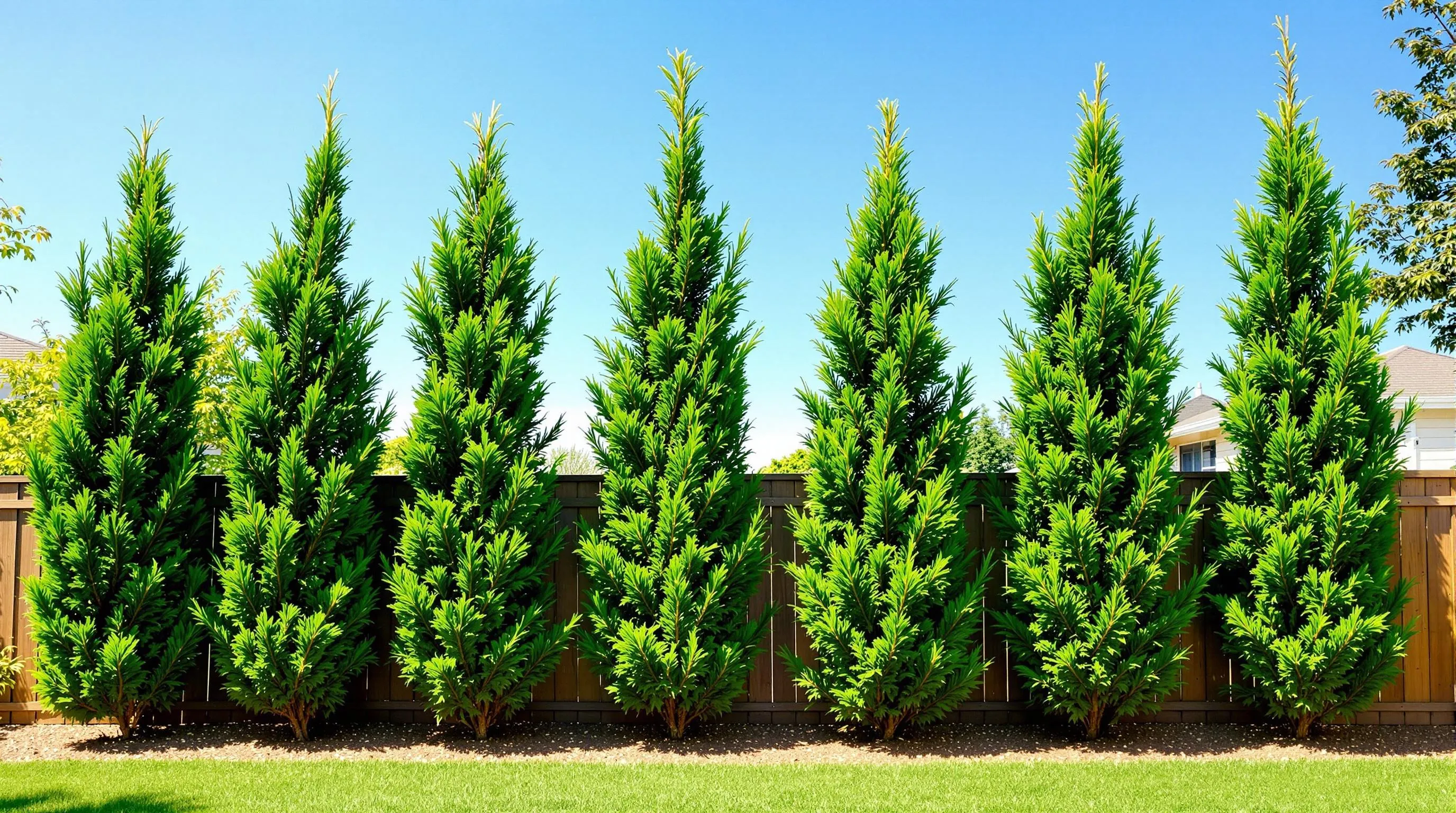
Italian Cypress trees (Cupressus sempervirens) offer a sophisticated, vertical accent to any privacy screen with their distinctive narrow, columnar shape. These Mediterranean natives grow 2-3 feet annually and can reach heights of 40-60 feet while maintaining a slender 3-5 foot width, making them perfect for tight spaces along fence lines.
Ideal Conditions for Maximum Growth
Italian Cypress trees thrive in full sun exposure and perform best in USDA hardiness zones 7-10. These drought-tolerant trees prefer well-draining soil with a neutral to slightly alkaline pH between 6.6-8.0. For maximum growth rates, plant Italian Cypress in locations receiving at least 6-8 hours of direct sunlight daily. While established trees rarely need supplemental watering, providing deep irrigation every 2-3 weeks during their first year promotes stronger root development. These trees naturally resist most pests and diseases, requiring minimal chemical treatments when planted in appropriate conditions. Their Mediterranean heritage makes them especially suited for hot, dry climates where other privacy trees might struggle.
Spacing Recommendations for Fence Lines
When planting Italian Cypress along fence lines, space trees 3-4 feet apart for a solid privacy screen or 4-6 feet apart for a more defined, columnar look with slight gaps. This tight spacing works because of their naturally narrow growth habit that won’t expand beyond 3-5 feet in width. For corners or entryways, consider placing pairs of trees to create a more formal, symmetrical appearance. Plant Italian Cypress 2-3 feet away from fence lines to allow sufficient room for root development while maintaining a clean visual line. Their non-invasive root systems won’t damage nearby structures, making them suitable for planting close to property boundaries. For longer fence lines exceeding 50 feet, consider creating visual breaks every 20-30 feet by incorporating a different variety or adjusting the spacing to prevent a monotonous appearance.
Eastern Red Cedar: Native Privacy Excellence
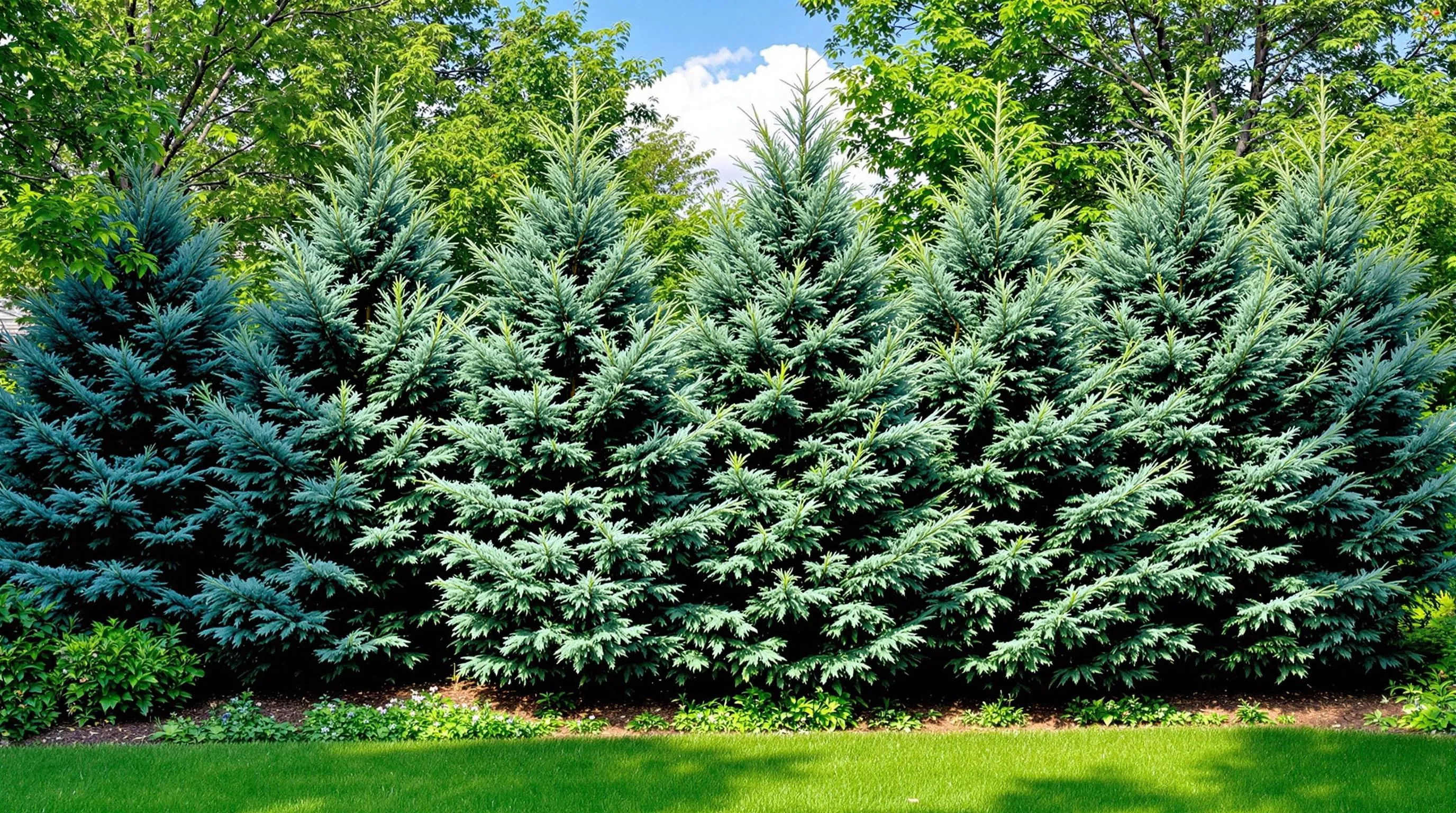
The Eastern Red Cedar offers a perfect combination of privacy and ecological benefits for homeowners looking to enhance their outdoor spaces. This native North American conifer grows 1-2 feet annually and thrives in diverse conditions, making it an excellent choice for natural fence line privacy that connects with the local network.
Drought Tolerance and Adaptability
Eastern Red Cedar stands out for its exceptional drought tolerance and adaptability to challenging soil conditions. Once established, these resilient trees require minimal watering, thriving in everything from rocky, alkaline soils to clay. You’ll appreciate their ability to grow in USDA hardiness zones 2-9, making them suitable for most of the continental United States. Unlike more finicky privacy trees, Eastern Red Cedars maintain their dense, blue-green foliage even during extended dry periods and can withstand temperature extremes from -40°F to 100°F without losing their screening effectiveness. Their natural resistance to salt spray also makes them ideal for coastal properties where other privacy options might struggle.
Wildlife Benefits While Maintaining Privacy
While creating your living privacy screen, Eastern Red Cedars simultaneously support local ecosystems. The dense foliage provides nesting sites for over 50 bird species including waxwings and robins, while the blue, berry-like cones offer critical winter food for wildlife. You’ll enjoy watching songbirds visit your property while maintaining complete privacy from neighbors. Eastern Red Cedars also serve as larval hosts for several butterfly species, improving your garden’s biodiversity without compromising the tree’s screening capabilities. The aromatic wood naturally repels moths and other pests, protecting your outdoor living spaces while creating a fragrant, private retreat that connects you to nature while shielding you from unwanted views.
Bamboo: The Fastest Growing Fence Screen
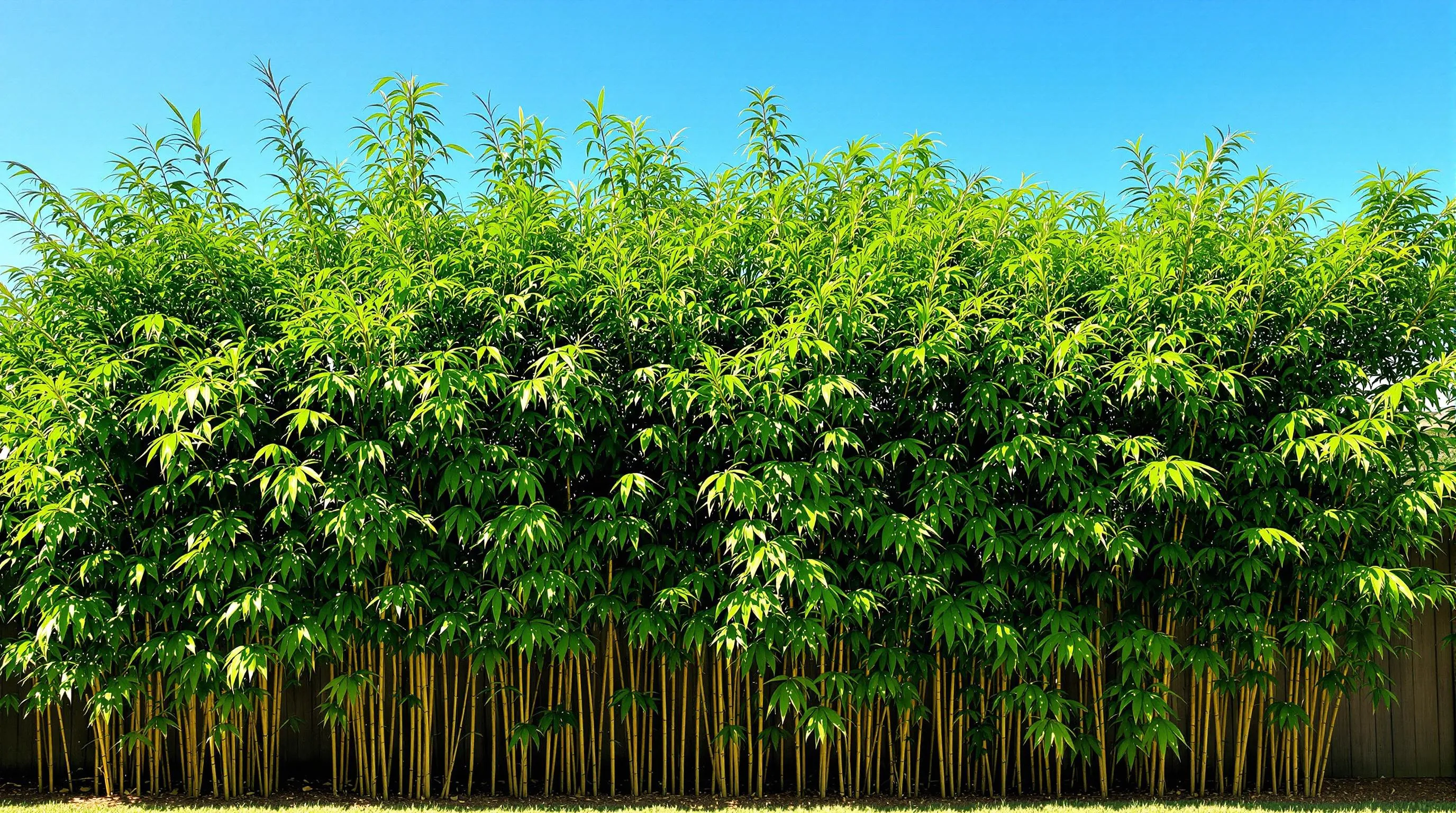
Bamboo offers unmatched growth rates of 3-5 feet per year, creating a dense privacy screen faster than almost any other plant. This versatile option provides instant seclusion with its tall culms and lush foliage, transforming your fence line into a natural sanctuary within just 1-2 growing seasons.
Containing Bamboo’s Aggressive Spread
Running bamboo varieties can quickly become invasive without proper containment systems. Install a specialized bamboo barrier made of high-density polyethylene at least 30 inches deep around your planting area to prevent unwanted spreading. These barriers should extend 2-3 inches above ground level to block shallow rhizomes from escaping. Alternatively, plant bamboo in large containers or raised beds with sealed bottoms to create a physical boundary. Regular maintenance is crucial—inspect the perimeter of your bamboo planting twice yearly and prune any rhizomes attempting to cross your barrier. Trenching around the bamboo grove every spring will also help manage its spread and maintain the privacy screen exactly where you want it.
Clumping vs. Running Varieties for Boundaries
Clumping bamboo varieties like Fargesia and Bambusa stay contained naturally, expanding only 1-3 inches annually from their original planting spot. These non-invasive options eliminate the need for extensive containment systems while still providing excellent privacy. Running bamboo species such as Phyllostachys grow faster and create denser screens but require vigilant management to prevent them from invading neighboring properties. For fence lines adjacent to property boundaries, choose clumping varieties like Fargesia robusta or Bambusa multiplex, which reach heights of 10-20 feet while remaining in their designated area. Running varieties like Phyllostachys vivax or Phyllostachys nigra work best when you have ample space and proper containment infrastructure. The trade-off is simple: clumping varieties offer peace of mind with slower spread, while running types provide faster coverage but demand more maintenance.
Nellie Stevens Holly: Evergreen Privacy With Berries
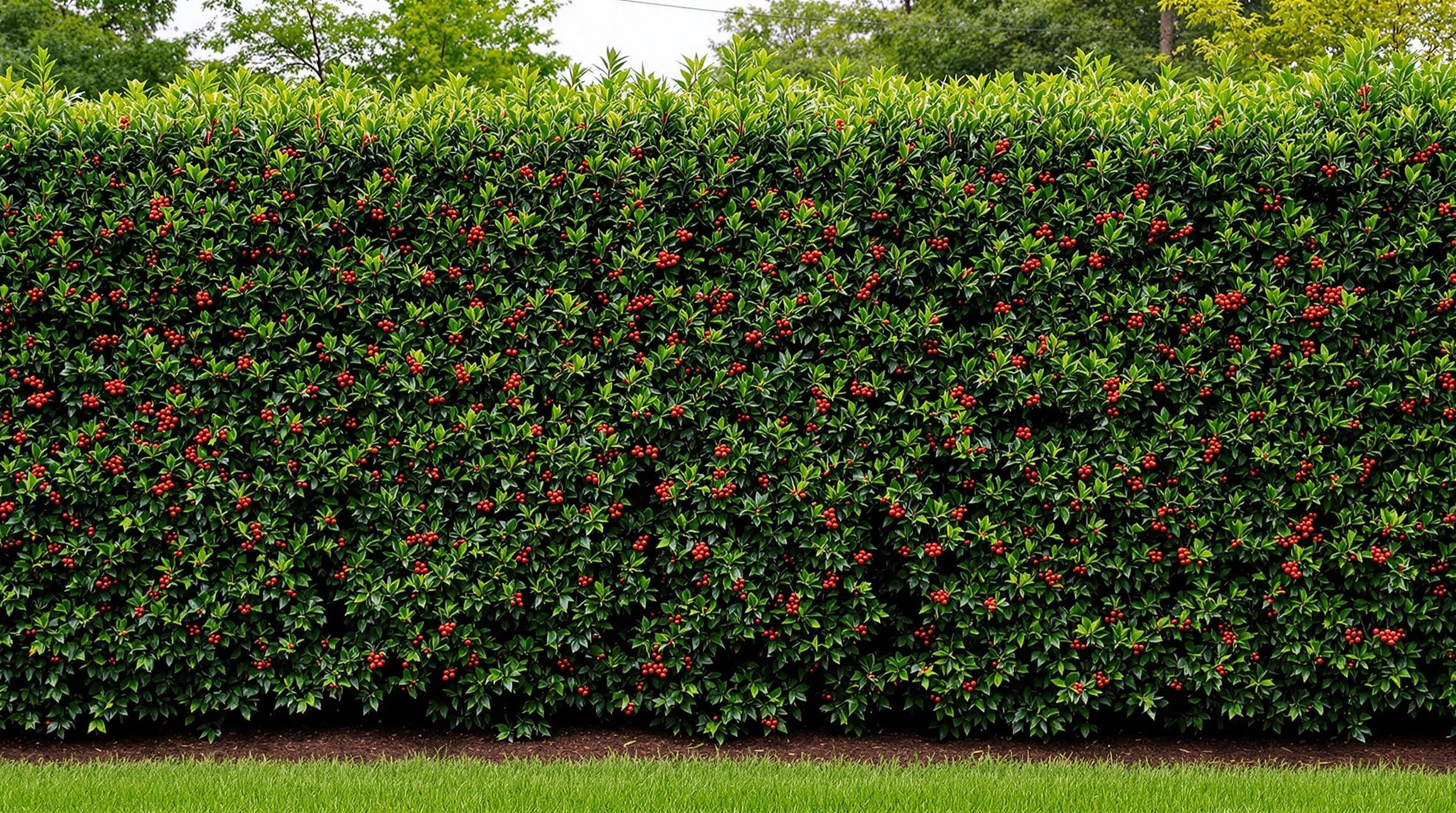
The Nellie Stevens Holly offers the perfect combination of privacy screening and ornamental value for your fence line. This broadleaf evergreen stands out among privacy trees for its attractive foliage and colorful berries that persist through winter.
Growth Rate and Ornamental Features
Nellie Stevens Holly grows at an impressive rate of 2-3 feet per year, quickly establishing a dense privacy screen along your property line. These stately evergreens reach mature heights of 15-25 feet with a spread of 8-12 feet, creating a substantial living wall without overwhelming smaller landscapes. The glossy, dark green leaves maintain their rich color year-round, while the distinctive serrated edges add visual interest to your garden backdrop. Female plants produce bright red berries from fall through spring, providing a striking contrast against the deep green foliage. These berries not only enhance the ornamental appeal but also attract songbirds to your yard, adding movement and life to your privacy screen. Nellie Stevens thrives in USDA hardiness zones 6-9 and adapts well to various soil types, tolerating both full sun and partial shade conditions.
Pruning Requirements for Dense Screening
Maintaining your Nellie Stevens Holly as an effective privacy screen requires minimal pruning effort compared to many fast-growing alternatives. For optimal density, plant these hollies 5-6 feet apart along your fence line, allowing their natural pyramidal shape to create a seamless barrier. Light annual pruning in late winter or early spring encourages branching and promotes denser foliage from top to bottom. Trim the branch tips selectively rather than shearing the entire plant to preserve the holly’s natural form while maintaining a tidy appearance. The stiff, closely spaced branches naturally grow in a pattern that resists gaps, even without frequent maintenance. For a more formal hedge appearance, you can shear Nellie Stevens twice yearly—once in spring after new growth emerges and again in mid-summer—to create crisp, defined edges. Unlike many fast-growing conifers, these hollies respond well to heavy pruning if needed, allowing you to rejuvenate older specimens without starting over.
Wax Myrtle: The Low-Maintenance Option
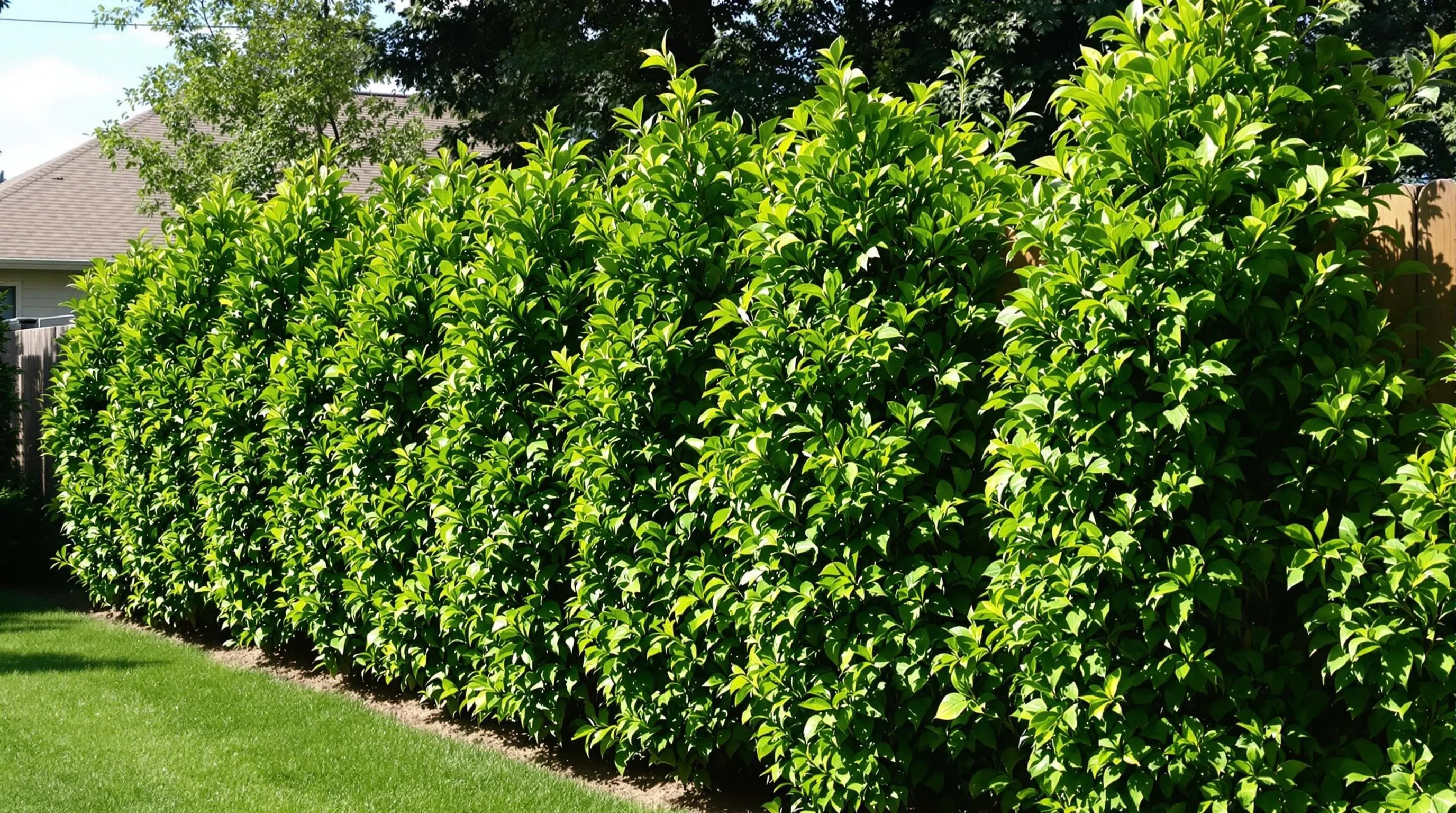
Wax Myrtle thrives as one of the most adaptable privacy trees for fence lines, growing rapidly at 3-5 feet per year while requiring minimal attention. This native evergreen reaches 8-15 feet tall and creates a dense, aromatic barrier that naturally repels mosquitoes and other insects.
Soil Adaptability and Growth Expectations
Wax Myrtle demonstrates exceptional soil adaptability, thriving in everything from wet, poorly drained soils to sandy, dry conditions. You’ll appreciate its ability to grow in acidic to slightly alkaline soils (pH 5.0-7.5) without showing signs of nutrient deficiency. For optimal growth, plant your Wax Myrtles 4-5 feet apart along your fence line, creating an overlapping privacy screen within 2-3 years. These versatile trees perform well in both full sun and partial shade, making them ideal for various locations around your property. Unlike fussier privacy trees, Wax Myrtles require minimal fertilization and establish quickly with just moderate watering during their first growing season.
Salt Tolerance for Coastal Properties
Wax Myrtle stands out among privacy trees for its remarkable salt tolerance, making it an exceptional choice for coastal properties. You can confidently plant these hardy evergreens in locations where salt spray and salty soils would damage other privacy options. Their waxy leaf coating provides natural protection against salt damage and desiccating coastal winds. This native species has evolved to withstand harsh coastal conditions throughout USDA hardiness zones 7-11, offering year-round screening even in challenging oceanfront environments. For maximum salt tolerance, plant your Wax Myrtles in slightly elevated beds with good drainage and apply a 2-3 inch layer of mulch to help moderate soil salinity levels and retain moisture.
Willow Hybrid: Deciduous Speed Champion
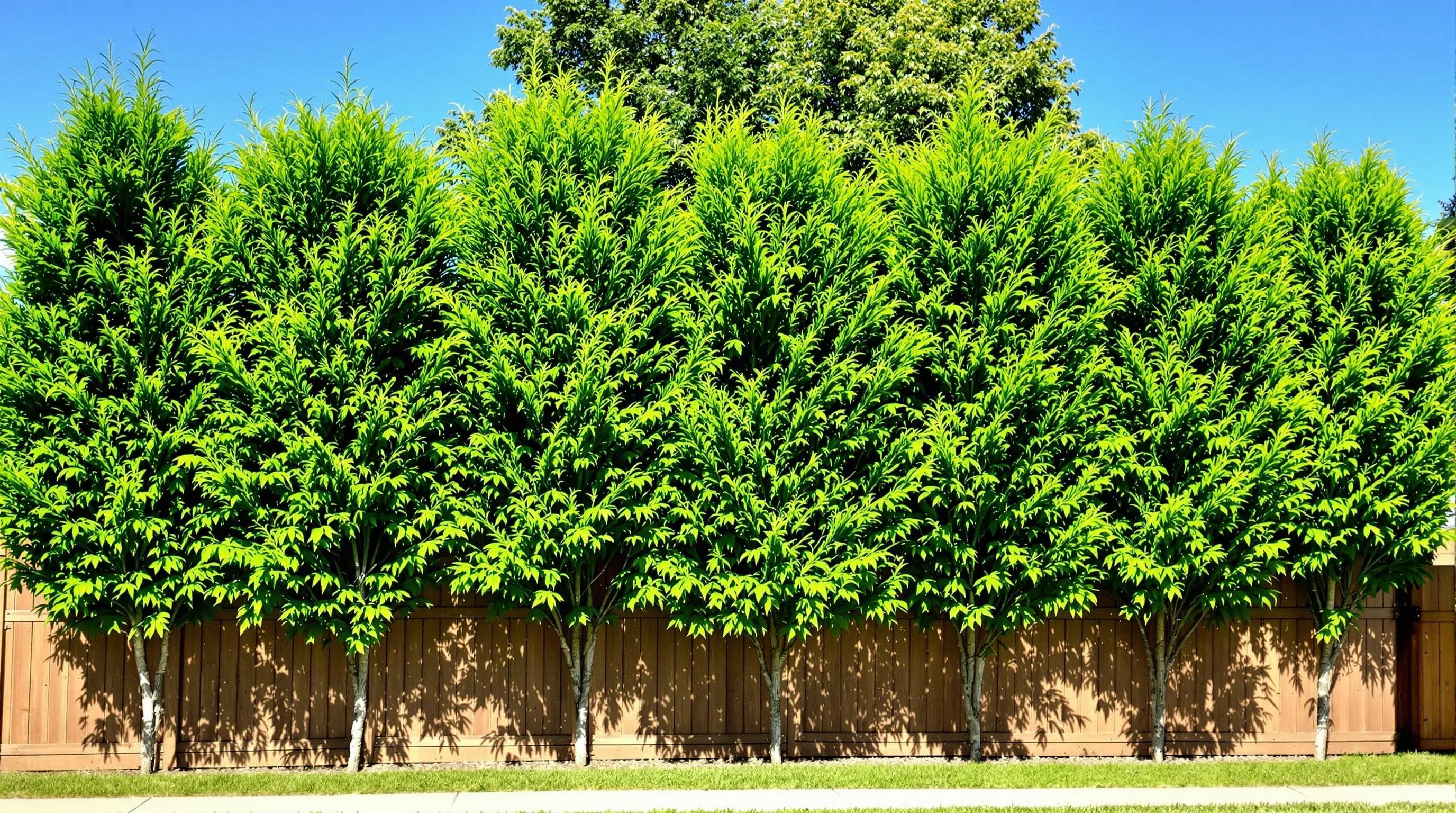
The Willow Hybrid stands out as the undisputed speed champion among privacy trees, growing an astonishing 6-10 feet per year. This deciduous powerhouse creates a dense screen faster than any other tree option, making it ideal for homeowners who need immediate privacy answers along fence lines.
Seasonal Considerations for Privacy
While Willow Hybrids lose their leaves in winter, they compensate with incredibly rapid growth during the growing season. Their thick branch structure still provides moderate screening even when dormant. For year-round privacy, consider planting evergreens like Thuja Green Giant or Leyland Cypress behind your Willow Hybrid row, creating a layered effect. Willow Hybrids thrive in USDA zones 4-9 and perform exceptionally well in moist conditions, making them perfect for properties with water features or naturally wet areas. During fall, their foliage transforms into stunning yellow hues, adding seasonal interest to your industry before leaf drop.
Planting Techniques for Quick Establishment
Willow Hybrids respond remarkably well to proper planting techniques that promote rapid establishment. Space trees 5-6 feet apart along your fence line for a solid screen within 1-2 growing seasons. Dig holes twice as wide as the root ball but at the same depth to encourage outward root growth. Amend soil with organic matter for improved drainage and nutrition. After planting, apply 2-3 inches of mulch around each tree, keeping it away from the trunk to prevent rot. Water deeply twice weekly during the first growing season, gradually reducing to once weekly in subsequent years. These trees benefit from annual pruning in late winter to maintain desired height and encourage denser growth patterns. Their extensive root systems seek water aggressively, so avoid planting near septic systems, water lines, or foundations.
Practical Tips for Planting Privacy Trees Along Fences
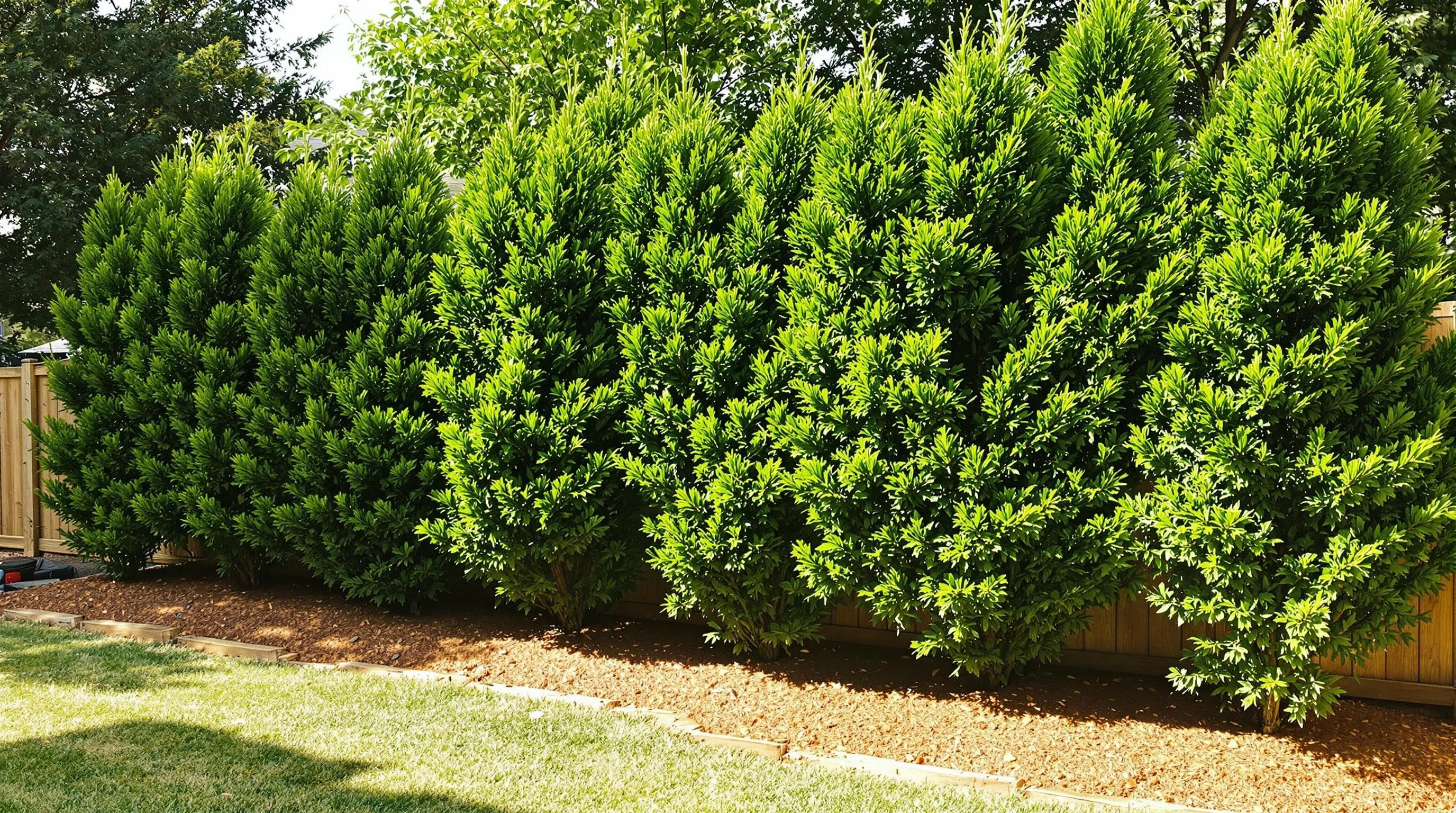
Proper Spacing and Setback Guidelines
Follow proper spacing guidelines to ensure your privacy trees develop optimally along your fence line. Space Thuja Green Giants 5-8 feet apart, Italian Cypress 3-4 feet apart, and Leyland Cypress 6-10 feet apart for an effective screen. Set trees back at least 2-4 feet from your fence to allow for mature width and prevent root interference with fence structures. For property boundaries, check local ordinances that might require setbacks of 6-24 inches from property lines. Consider the mature height when planting near utility lines, staying at least 15 feet away from overhead wires. Remember that proper spacing prevents disease issues from poor air circulation while still achieving the density needed for privacy.
Soil Preparation and Irrigation Systems
Prepare your soil thoroughly before planting privacy trees for faster establishment and healthier growth. Start by testing your soil pH and amending accordingly—most privacy trees prefer slightly acidic to neutral soil (pH 6.0-7.0). Dig holes twice as wide as the root ball but only as deep, mixing native soil with 25% compost to improve drainage and fertility. Install a drip irrigation system along your fence line to deliver consistent moisture directly to root zones while conserving water. For trees like Willow Hybrids that need consistent moisture, soaker hoses work exceptionally well. Apply 2-3 inches of mulch around each tree, keeping it 3 inches away from trunks to prevent rot. This combination of proper soil preparation and efficient irrigation can accelerate growth rates by up to 30% in the first few years.
Common Mistakes to Avoid When Growing Privacy Trees
Transforming your yard with fast-growing privacy trees is an investment that pays dividends in comfort and property value. By selecting the right varieties like Leyland Cypress or Thuja Green Giant you’ll create your secluded haven in just a few growing seasons.
Remember that proper spacing and soil preparation aren’t optional but essential for healthy growth. Install trees at the recommended distance from your fence and provide adequate water especially during establishment.
Your privacy screen will flourish with minimal maintenance when you choose trees suited to your climate zone. Avoid the temptation to overcrowd them which leads to competition for resources and slower growth.
With the right planning your living fence will provide decades of beauty privacy and environmental benefits while turning your outdoor space into the retreat you’ve always wanted.

